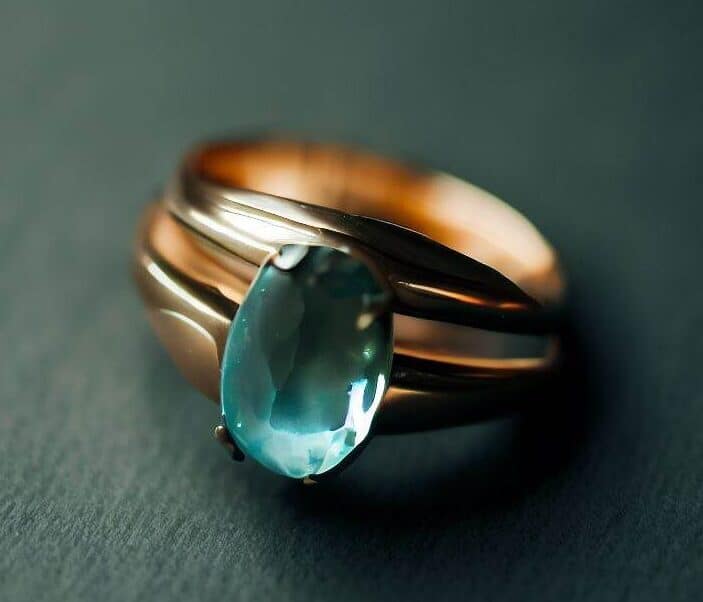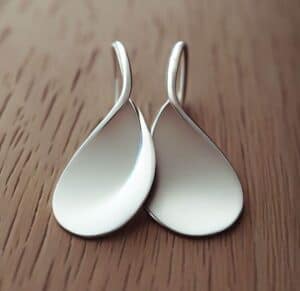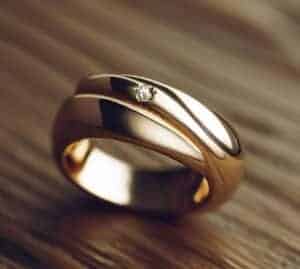Ring
Origin of the ring in jewelry
The origin of the ring in jewelry dates back to ancient times, and its use has had different meanings and purposes throughout history. It is believed that the first rings were used thousands of years ago in ancient cultures of Mesopotamia, Egypt, India, and other early civilizations.
Some highlights about the origin of the ring in jewelry:
- Symbolism and meaning: Since ancient times, rings have held deep symbolic meanings. In some cultures, they were considered symbols of status, wealth, or power. They were also used as signs of engagement or marriage, representing the bond between two people.
- Materials: Initially, rings were mainly crafted from natural materials such as bone, leather, stones, and wood. As metallurgy advanced, more elaborate rings were created using precious metals like gold, silver, and platinum.
- Adornments and decorations: Rings were often adorned with gemstone inlays and engravings to add beauty and significance. Precious gemstones like rubies, sapphires, and emeralds were considered special and reserved for more valuable rings.
- Ceremonial and religious uses: Rings also played an important role in religious and ceremonial rituals. In some cultures, they were used in rites of passage, such as weddings, engagements, investitures, and funerals.
- Rings as seals: In ancient civilizations, rings were also used as personal or official seals. They were engraved with special inscriptions or symbols and pressed into clay or wax to authenticate documents or shipments.
- Evolution in design: Over time, the shape and design of rings have evolved. In the medieval era, signet rings with heraldic shields were popular, while in the Renaissance, rings with precious gemstones became fashionable.
Today, rings remain one of the most popular forms of jewelry worldwide. Designs can vary greatly, and rings are still appreciated for their symbolism, beauty, and sentimental value. From engagement rings to wedding bands and fashion rings, these pieces of jewelry continue to be an essential part of culture and tradition in many societies.
A ring is a piece of jewelry worn on the finger. Usually, rings are made of precious metals such as gold, silver, platinum, or a combination of them, although they can also be made of less valuable materials such as stainless steel, titanium, or copper.
Rings are used for both decorative and symbolic purposes. They are often used as symbols of engagement or marriage and can be engraved with names, dates, or personal messages. They are also used as symbols of status, such as in the case of graduation rings and championship rings in sports.
Rings can have simple or intricate designs, with gemstones or diamonds embedded. Some rings are designed with specific motifs, such as rings with religious symbols or rings with nature-inspired designs.
The ring is one of the most popular pieces in jewelry due to its versatility and symbolic meaning. Rings can be worn by both men and women, and they can be found in a wide range of styles and prices to suit different tastes and budgets.
The Ring in Ancient Mesopotamia
In ancient Mesopotamia, rings held significant cultural and symbolic importance, and their use dates back thousands of years. This region, located in the present-day Middle East and known as the "Cradle of Civilization," encompassed territories that now include Iraq, Syria, Turkey, and parts of Iran. Here are some highlighted features about the use and meaning of rings in ancient Mesopotamia:
- Symbolism and Status: Rings in ancient Mesopotamia were symbols of status and power. They were used not only as ornaments but also as signs of social position and authority for those who wore them. Rulers and nobles in Mesopotamian society could wear specially crafted rings to display their elevated position.
- Functions and Purposes: Rings served various functions and purposes. Besides their use as status symbols, they were also employed as protective amulets, talismans to attract good luck, and as offerings to gods in religious rituals.
- Materials and Decorations: Rings in ancient Mesopotamia were made with a variety of materials, including gold, silver, bronze, and precious stones like lapis lazuli. These materials, along with engravings and settings, were used to enhance the beauty and significance of the ring.
- Design and Shape: Designs of Mesopotamian rings could be quite diverse. Some were in the form of cylinder seals with inscriptions engraved on them, which were used to authenticate official documents or shipments. Others had more elaborate shapes with figures and symbols reflecting religious and cultural beliefs.
- Religious and Spiritual Use: In ancient Mesopotamia, religion had a strong presence in daily life. Rings could be associated with specific deities or gods and were used in religious ceremonies and rituals as offerings or protective amulets.
- Rings in Society: Aside from their religious and symbolic functions, rings were also common in people's daily lives. They were used as personal adornments and, in some cases, exchanged as gifts or as part of commercial and legal agreements.
Rings had deep and multifaceted meanings, extending beyond their aesthetic value. They were symbols of status, power, protection, and religious devotion, and they were an important part of the culture and everyday life in this ancient civilization.
The Ring in Ancient Egypt
In ancient Egypt, rings also held great cultural and symbolic importance. These rings were more than mere ornaments; they had profound significance and were used in various situations, both in daily life and in rituals and ceremonies.
Here are some highlighted features about the use and meaning of rings in ancient Egypt:
- Symbolism and Status: Rings in ancient Egypt were symbols of status and power. They were used to distinguish individuals of high rank and authority in society, such as pharaohs, high officials, priests, and nobles.
- Amulets and Protection: Rings also served as amulets and were believed to provide protection and good luck to those who wore them. Many rings had magical symbols and amulets engraved on them to offer protection against evil forces and ensure a safe journey to the afterlife.
- Religious and Ritual Use: Rings played an important role in Egyptian religion and were used in religious ceremonies and rituals. Some rings, especially signet rings, were used as protective amulets in the tombs of the deceased.
- Materials and Decoration: Egyptian rings were crafted with various materials, including precious metals like gold and silver, as well as precious and semi-precious stones. Some rings had inscriptions, hieroglyphics, or sacred symbols engraved on them.
- Seal Rings: Rings with seals were common in ancient Egypt and were used as instruments of identification and authentication. Pharaohs and high-ranking officials had seal rings with their names engraved on them, and these were used to stamp official documents.
- Funerary Rings: Funerary rings were especially significant in Egyptian culture. They were placed on the fingers of the deceased to protect them on their journey to the afterlife and as symbols of eternity.
Rings in ancient Egypt had deep symbolic meaning and were used to reflect status, power, and protection in both daily life and the religious sphere. They were jewelry pieces charged with significance, and their use was closely connected to the beliefs and traditions of this ancient civilization.
The Ring in Indian Culture
In Indian culture, the ring also holds great significance and is a significant part of tradition and everyday life. Rings in Indian culture are laden with symbolism and are used on various occasions, ceremonies, and social events. Here are some key features about the use and meaning of the ring in Indian culture:
- Symbolism and Meaning: Rings in Indian culture have deep symbolic meaning. They are used as symbols of commitment, marriage, and love, and are often exchanged as part of wedding and engagement ceremonies. Additionally, rings can also serve as amulets of protection and good fortune.
- Different Styles and Designs: Rings in Indian culture showcase a wide variety of styles and designs. They can be simple and elegant or intricately adorned with gemstones and intricate motifs, depending on the occasion and personal taste.
- Use in Religious Ceremonies: Rings are also used in religious ceremonies and rituals in Indian culture. For example, in some Hindu traditions, rings are offered as offerings during pujas (worship ceremonies) at temples.
- Importance in Fashion: Rings are an essential part of fashion and attire in Indian culture. Both men and women wear them as accessories to complement their outfits, and their choice can reflect personal taste and social status.
- Traditional Rings: Some rings hold traditional value and are passed down from generation to generation as family heirlooms. These rings may be linked to family stories and legends and carry special sentimental significance.
- Religious and Spiritual Rings: In Indian culture, there are also religious and spiritual rings with sacred symbols or deities engraved on them. These rings can be worn as protective amulets or as a way of spiritual connection.
- Celebrity and Politician Rings: In Indian culture, political leaders and celebrities are often seen wearing rings that become recognizable symbols of their status and power.
Rings are considered more than simple jewelry; they are symbols of emotional, spiritual, and social connection in the lives of people in Indian culture.
The Ring in Chinese Culture
In Chinese culture, the ring also holds significant importance and deep symbolism. Rings have been used throughout Chinese history on various occasions, from traditional ceremonies to symbols of status and wealth. Here are some key features about the use and meaning of the ring in Chinese culture:
- Symbolism of Union and Eternity: In Chinese culture, the ring is associated with the concept of union and eternity. Rings are commonly used in wedding ceremonies as symbols of commitment and lasting connection between the couple.
- Gifts and Amulets: Rings are often exchanged as gifts to express affection and friendship. They can also be used as amulets of good luck and protection against negative energies.
- Traditional Jewelry: Jade rings hold special significance in Chinese culture. Jade is considered an auspicious gemstone and holds symbolic value associated with wisdom, harmony, and immortality. Jade rings are often inherited from generation to generation and considered family treasures.
- Engagement and Wedding Rings: Similar to other cultures, rings also play an important role in engagement and wedding ceremonies in China. Engagement and wedding rings symbolize love and mutual commitment between the couples.
- Symbols of Status and Wealth: In ancient times, rings were also used as symbols of status and wealth. Officials and nobles in the Chinese imperial court wore ornate rings made of precious metals and gemstones to display their social position and wealth.
- Spiritual Meaning: In some Chinese spiritual traditions, rings also hold spiritual meaning. They are believed to have protective properties and strengthen the connection with the divine.
- Art and Design: Chinese rings often feature elaborate designs and intricate details, reflecting the rich artistic tradition and craftsmanship of Chinese culture. Designs may be inspired by traditional Chinese symbols such as dragons, phoenixes, and Chinese characters.
The ring in Chinese culture carries deep cultural and symbolic meaning. It is used on various occasions, from wedding ceremonies to expressions of friendship and affection. Furthermore, rings have historically been symbols of status, wealth, and spiritual connection in the rich Chinese tradition.
The Ring in Muslim Culture
Its use is related to religious and cultural traditions in Islam. Here are some key features about the ring in Muslim culture and practices:
- The Ring of Prophet Muhammad: According to Islamic tradition, Prophet Muhammad had a special ring known as the "Seal of the Prophet" (خاتم النبي), which he supposedly wore as a personal seal. This ring is believed to have inscriptions that included the name of Allah and the name of Muhammad and is considered an important symbol in Islamic history and culture.
- The Seal of Solomon: In some Muslim cultures, the "Seal of Solomon" (خاتم سليمان), also known as the "Sello de Prophethood," is associated with power and spiritual protection. It is said that this ring was worn by the prophet Solomon and has inscriptions linking it to wisdom and divine authority.
- Wedding ring: Like in other cultures, rings are also used as symbols of commitment and marriage in Muslim wedding ceremonies. The wedding ring is placed on the bride's finger during the ceremony and represents the commitment and union between the couple.
- Personal seals and signatures: Some Muslims use rings with personal seals or inscriptions to authenticate documents and sign official correspondence. These types of rings are known as "khātam" or "shāhādah ring" and may contain inscriptions reflecting their faith and religious beliefs.
- Rings as amulets: In some Muslim cultures, rings are used as protective amulets to attract blessings and good luck. They may contain inscriptions of Quranic verses or names of God to provide spiritual protection and blessings.
It is important to note that the use of the ring may vary according to different cultures and traditions within Islam. Some of the examples mentioned above may be more common in certain regions or specific Muslim communities. Overall, the ring in Muslim culture can have both religious and cultural significance, and its use may be linked to specific spiritual beliefs and traditions.
History of Engagement Rings
The tradition of giving a ring to the bride during the marriage proposal has its roots in various cultures and traditions throughout history. Nowadays, the act of presenting a ring during a marriage proposal is a widespread tradition in many cultures around the world.
The engagement ring is a tangible symbol of love and commitment between two people and marks the formal beginning of preparations for marriage. The choice of the ring may vary according to the preferences and budget of the couples, and it is a meaningful gesture that represents the desire to share a life together in the near future.
The history of the engagement ring has deep roots in different cultures and civilizations throughout history. Here is a summary of its evolution over time:
- Ancient Egypt: The use of engagement rings is believed to date back to ancient Egypt around 2800 BC. Egyptians used rings with symbols and hieroglyphics representing love and eternal union between two people. The rings also symbolized eternity and the endless cycle of love.
- Ancient Rome: In ancient Rome, rings were used as symbols of marital engagement. Romans exchanged iron rings, symbolizing the formal commitment before the wedding. Over time, the tradition evolved, and gold rings began to be used as symbols of enduring marital union.
- Middle Ages: During the Middle Ages, engagement rings acquired a more specific meaning in Christian cultures. They became a symbol of unity and fidelity between two people and were used to formalize the commitment before the religious wedding.
- Renaissance: In the Renaissance, engagement rings became more elaborate and symbols of status and wealth. The rings often featured intricate designs and were adorned with gemstones and engravings.
- Gimmel Ring: In the 16th century, the "Gimmel Ring" became popular, consisting of two or three interconnected bands that were disassembled and worn by the bride and groom. In the wedding ceremony, the bands were joined to form a single ring symbolizing marital union.
- Subsequent centuries: Over time, the use of the engagement ring expanded to different cultures and regions of the world, and its symbolic meaning remained. Engagement rings continued to be symbols of love, commitment, and union between two people.
- 20th century and beyond: In the 20th century, diamonds became a popular choice for engagement rings, especially after a successful advertising campaign by the company De Beers in the 1940s that popularized the phrase "A diamond is forever."
Today, engagement rings remain a significant and cherished symbol in wedding ceremonies in many cultures around the world. The engagement ring is a tangible expression of love and commitment between two people, and its rich and diverse history makes it a lasting tradition in global matrimonial culture.
Classification of Rings
Rings in jewelry can be classified in various ways based on different criteria, such as the type of design, the material used, the purpose, or the occasion of use. Here is a general classification of ring types in jewelry:
Ring design and style
- Solitaire rings: with a single gemstone or diamond in the center.
- Band rings: with a simple design and no gemstones, usually used as wedding bands.
- Halo rings: that surround a central stone with a halo of smaller stones.
- Three-stone rings: with three stones, symbolizing the past, present, and future.
- Cocktail rings: Large and flashy rings with colorful gemstones and extravagant designs.
Rings material
- Gold: Rings made of gold, which can be of different carats (10K, 14K, 18K, etc.).
- Silver: Rings made of silver, which can be plain or adorned with gems.
- Platinum: Rings made of platinum, a durable and resilient precious metal.
- Stainless steel: Rings made of stainless steel, a more affordable and sturdy option.
Ring gemstone or gem
- Diamond: diamonds as the central stone or as accents.
- Sapphire, ruby, and emerald rings: these precious gemstones as the main feature.
- Semi-precious gem: Rings with stones like topaz, amethyst, peridot, among others.
Rings purpose or occasion:
- Engagement: Symbolizing the commitment to marriage.
- Wedding: Exchanged during the wedding ceremony.
- Graduation: Used to commemorate a student's graduation.
- Anniversary: Given as gifts on anniversaries.
Ring by cultural style:
- Ethnic rings: Rings inspired by traditional styles and designs from different cultures.
- Claddagh rings: Rings with the traditional Irish design of hands holding a crowned heart.
- Rings with religious symbols: Rings with religious symbols like crosses, Stars of David, etc.
These classifications are just examples, and there may be variations and combinations in jewelry rings based on individual preferences and the creativity of jewelry designers.


Sandra Sanchez
Sandra is passionate about jewelry and interior design. She graduated in interior design from Universidad Taller 5 in Colombia and has completed several courses and postgraduate studies in Jewelry in Barcelona and Madrid, Spain. She combines her work as a jeweler and interior designer with teaching.


